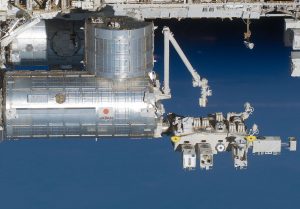19 May 2017
Early Tanpopo mission results show microbes can survive in space
Posted by larryohanlon
By Larry O’Hanlon
Clumps of microbes can survive in space for at least a year – and perhaps longer, according to Japanese researchers conducting an experiment on board the International Space Station (ISS).
The Japanese Tanpopo mission is designed to test the panspermia hypothesis – the idea that life can be transferred from one planet to another by way of rocky debris. The mission is also aimed at testing the hypothesis that compounds that are precursors for life might have rained down on early Earth from space. Researchers are presenting initial results from the first year of the mission at the JpGU-AGU joint meeting next week.

The Tanpopo experiment, developed by Japanese scientists, started in May 2015 using the Exposed Facility located on the exterior of Kibo, the Japanese Experimental Module of the International Space Station. Image credit: NASA
To do the experiment, capture panels and exposure panels were attached to the outside of the ISS. The capture panels are made of aerogel that can capture micrometeorites zipping through space which might harbor life from Earth. The exposure panels are aluminum plates with tiny holes loaded with microorganisms that are exposed to space to see how well and how long the microbes survive.
Previous panspermia experiments by other space agencies involved very thin layers of microbes, which all died, or microbes mixed with clay and other materials. The Tanpopo mission’s panels include thicker layers of microbes not mixed with any other materials to see how clumps of microbes might survive in space.
After the first year of exposure, at least 54 high-velocity impact tracks – caused by particles shooting through the aerogel – have been found, said Akihiko Yamagishi, a molecular biology professor at Tokyo University of Pharmacy and Life Science in Japan, and principal investigator for the Tanpopo mission. Particles were found at the ends of some of the tracks and a handful are now being studied for evidence of microorganisms and organic compounds.
Early results from bacteria on the exposure panels show evidence that some microbes can survive for at least a year in space. The top layer of one type of radioactivity-resistant bacteria loaded onto the exposure panels, Deinococcus radiodurans, did not survive the year-long space exposure, but this top layer of dead microbes appears to have protected the living cells underneath, said Yamagishi.
“We have found that [the lower layers] survived for a year, even exposed to sunlight in a space vacuum, if the thickness of the cell layer is greater than 0.5 millimeters,” said Yamagishi. These results support the idea that clumps of microorganisms could be one way for life to spread from planet to planet, he said.
Scientists will have additional data to support their initial findings when panels from the second year of the mission are brought back to Earth this fall, and panels from the third year of the mission return to Earth a year later.
— Larry O’Hanlon is a freelance science writer, editor and social media manager in New Mexico. He manages the AGU blogosphere. Follow him on Twitter at @Earth2larryo. The initial results from the first year of the mission are being presented Wednesday, May 24 at the JpGU-AGU joint meeting in Chiba, Japan.


 GeoSpace is a blog on Earth and space science, managed by AGU’s Public Information staff. The blog features posts by AGU writers and guest contributors on all sorts of relevant science topics, but with a focus on new research and geo and space sciences-related stories that are currently in the news.
GeoSpace is a blog on Earth and space science, managed by AGU’s Public Information staff. The blog features posts by AGU writers and guest contributors on all sorts of relevant science topics, but with a focus on new research and geo and space sciences-related stories that are currently in the news.